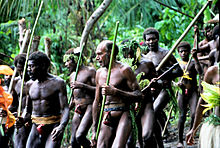
A namba (or nambas) is a traditional penis sheath from Vanuatu. [1] Nambas are wrapped around the penis of the wearer, sometimes as their only clothing. [2] Two tribes on Malakula, the Big Nambas and the Smol (Small) Nambas, are named for the size of their nambas. [3]
Contents
Nambas are characteristic of central Vanuatu. In the northern islands, long mats wrapped around the waist are worn instead.